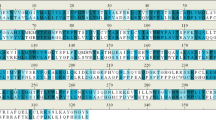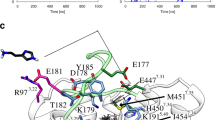Summary
A modelling study has been carried out, investigating the binding of histamine (Hist), 2-methylhistamine (2-MeHist) and 2-phenylhistamine (2-PhHist) at two postulated agonistic binding sites on transmembrane domain 5 (TM5) of the histamine H1-receptor. For this purpose a conformational analysis study was performed on three particular residues of TM5, i.e., Lys200, Thr203 and Asn207, for which a functional role in binding has been proposed. The most favourable results were obtained for the interaction between Hist and the Lys200/Asn207 pair. Therefore, Lys200 was subsequently mutated and converted to an alanine, resulting in a 50-fold decrease of H1-receptor stimulation by histamine. Altogether, the data suggest that the Lys200/Asn207 pair is important for activation of the H1-receptor by histamine. In contrast, analogues of 2-PhHist seem to belong to a distinct subclass of histamine agonists and an alternative mode of binding is proposed in which the 2-phenyl ring binds to the same receptor location as one of the aromatic rings of classical histamine H1-antagonists. Subsequently, the binding modes of the agonists Hist, 2-MeHist and 2-PhHist and the H1-antagonist cyproheptadine were evaluated in three different seven-α-helical models of the H1-receptor built in homology with bacteriorhodopsin, but using three different alignments. Our findings suggest that the position of the carboxylate group of Asp116 (TM3) within the receptor pocket depends on whether an agonist or an antagonist binds to the protein; a conformational change of this aspartate residue upon agonist binding is expected to play an essential role in receptor stimulation.
Similar content being viewed by others
Abbreviations
- 2-MeHist:
-
2-methylhistamine
- 2-PEA:
-
2-pyridyl-ethylamine
- 2-PhHist:
-
2-phenylhistamine
- CHO:
-
Chinese hamster ovary
- Eint :
-
interaction energy
- Estr :
-
strain energy
- GES:
-
global energy structure
- gpH1R:
-
guinea pig H1-receptor
- GPCR:
-
G-protein coupled receptor
- Hist:
-
histamine
- Nπ :
-
proximal nitrogen
- Nτ :
-
tele nitrogen
- TM:
-
transmembrane domain
- WT:
-
wild type
References
Cooper, D.G., Young, R.C., Durant, G.J. and Ganellin, C.R., In Hansch, C., Sammes, P.G. and Taylor, J.B. (Eds) Comprehensive Medicinal Chemistry, Pergamon Press, Oxford, 1990.
Koper, J.G., Van derVliet, A., Van derGoot, H. and Timmerman, H., Pharm. Weekbl., 12 (1990) 236.
Zingel, V., Elz, S. and Schunack, W., Eur. J. Med. Chem., 25 (1990) 673.
Zingel, V. and Schunack, W., Pharmazie, 48 (1993) 483.
Leurs, R., Smit, M.J., TerLaak, A.M. and Timmerman, H., Biochem. Biophys. Res. Commun., 201 (1994) 295.
Traiffort, E., Leurs, R., Arrang, J.M., Tardivel-Lacombe, J., Diaz, J., Schwartz, J.-C. and Ruat, M., J. Neurochem., 62 (1994) 507.
Ohta, K., Hayashi, H., Mizuguchi, H., Kagamiyama, H., Fujimoto, K. and Fukui, H., Biochem. Biophys. Res. Commun., 203 (1994) 1096.
Strader, C.D., Candelore, M.R., Hill, W.S., Sigal, I.S. and Dixon, R.A.F., J. Biol. Chem., 264 (1989) 13572.
Gantz, I., DelValle, J., Wang, L., Tashiro, T., Munzert, G., Guo, Y., Konda, Y. and Yamada, T., J. Biol. Chem., 267 (1992) 20840.
Henderson, R., Baldwin, J., Ceska, T.H., Zemlin, F., Beckmann, E. and Downing, K., J. Mol. Biol., 213 (1990) 899.
Hibert, M.F., Trumpp-Kallmeyer, S., Bruinvels, A. and Hoflack, J. Mol. Pharmacol., 40 (1991) 8.
Trumpp-Kallmeyer, S., Hoflack, J., Bruinvels, A. and Hibert, M.F., J. Med. Chem., 35 (1992) 3448.
Lewell, X.Q., Drug Des. Discov., 9 (1992) 29.
IJzerman, A.P., VanGalen, P.J.M. and Jacobsen, K.A., Drug Des. Discov., 9 (1992) 49.
Pardo, L., Ballesteros, J.A., Osman, R. and Weinstein, H., Proc. Natl. Acad. Sci. USA, 89 (1992) 4009.
Timms, D., Wilkinson, A.J., Kelly, D.R., Broadley, K.J. and Davies, R.H., Int. J. Quant. Chem., Quant. Biol. Symp., 19 (1992) 197.
Cronet, P., Sander, C. and Vriend, G., Protein Eng., 6 (1993) 59.
Oliveira, L., Paiva, A.C.M. and Vriend, G., 7TM, 1 (1993) 13.
Ter Laak, A.M., Venhorst, J., Donné-Op den Kelder, G.M. and Timmerman, H., J. Med. Chem., (1995) in press.
Ippolito, J.A., Alexander, R.S. and Christianson, D.W., J. Biol. Chem., 215 (1990) 457.
Weiner, S.J., Kollman, P.A., Nguyen, D.T. and Case, D.A., J. Comput. Chem., 7 (1986) 230.
ChemX Reference Guide, Chemical Design Ltd., Oxon, July 1993.
Schertler, G.F.X., Villa, C. and Henderson, R., Nature, 362 (1993) 770.
Hunter, C.A., Singh, J. and Thornton, J.M., J. Mol. Biol., 218 (1991) 837.
Weinstein, H., In Bonati, L., Cosentino, U., Lasagni, M., Moro, G., Pitea, D. and Schiraldi, A. (Eds) Molecular Mechanics in Ecological Physical Chemistry, Elsevier, Amsterdam, 1993, pp. 1–16.
Oliveira, L., Paiva, A.C.M., Sander, C. and Vriend, G., Trends Pharmacol. Sci., 15 (1994) 170.
Timms, D., Wilkinson, A.J., Kelly, D.R., Broadley, K.J. and Davies, R.H., Recept. Channels, 2 (1994) 107.
Donné-Op den Kelder, G.M., Nederkoorn, P. and Timmerman, H., In Trends in QSAR and Molecular Modelling 94 (Proceedings of the 10th European Symposium on Structure-Activity Relationships), J.R. Prous, S.A., 1994, in press.
Nederkoorn, P., Donné-Op den Kelder, G.M. and Timmerman, H., Trends Pharmacol. Sci., 16 (1995) 156.
Leurs, R., Smit, M.J., Meeder, R., Ter Laak, A.M. and Timmerman, H., Biochem. Biophys. Res. Commun., (1995) in press.
Author information
Authors and Affiliations
Rights and permissions
About this article
Cite this article
ter Laak, A.M., Timmerman, H., Leurs, R. et al. Modelling and mutation studies on the histamine H1-receptor agonist binding site reveal different binding modes for H1-agonists: Asp116 (TM3) has a constitutive role in receptor stimulation. J Computer-Aided Mol Des 9, 319–330 (1995). https://doi.org/10.1007/BF00125173
Received:
Accepted:
Issue Date:
DOI: https://doi.org/10.1007/BF00125173




